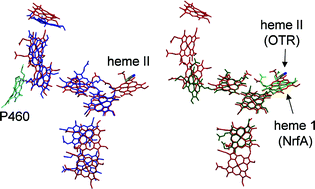Multi-heme cytochromes—new structures, new chemistry†
Abstract
Heme is one of the most pervasive cofactors in nature and the c-type cytochromes represent one of the largest families of heme-containing proteins. Recent progress in bacterial genomic analysis has revealed a vast range of genes encoding novel c-type cytochromes that contain multiple numbers of heme cofactors. The genome sequence of Geobacter sulfurreducens, for example, includes some one hundred genes encoding c-type cytochromes, with around seventy of these containing two, or more, heme groups and with one protein containing an astonishing twenty seven heme groups. This wealth of cytochromes is of great significance in the respiratory flexibility shown by bacteria such as Geobacter. In addition, we are now discovering that many of these multi-heme cytochromes have associated enzymatic activities and in some cases this is revealing new chemistries. The purpose of this perspective is to describe recent progress in the structural and functional analyses of these new multi-heme cytochromes. To illustrate this we have chosen to focus on three of these cytochromes which exhibit catalytic activities; nitrite reductase, hydroxylamine oxidoreductase and tetrathionate reductase. In addition we consider the multi-heme cytochromes from Geobacter and Desulfovibrio species. Finally, we consider and contrast the repeating structural modules found in these multi-heme cytochromes.


 Please wait while we load your content...
Please wait while we load your content...